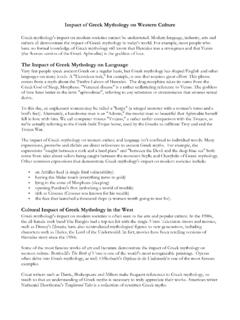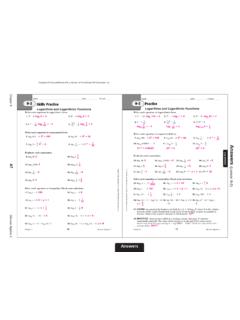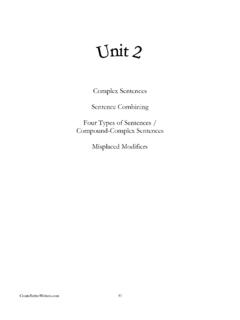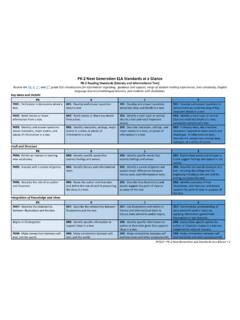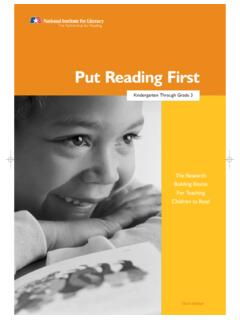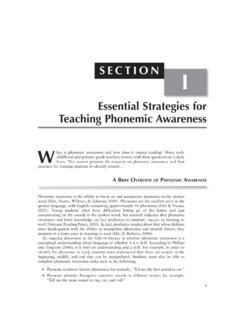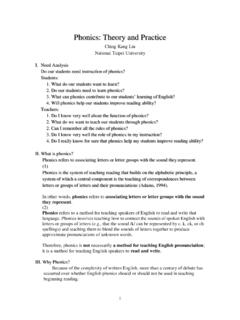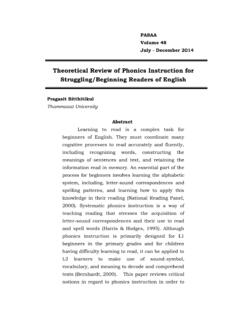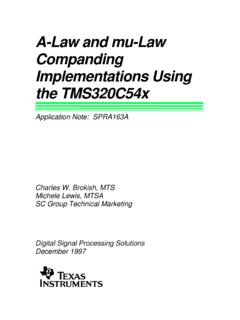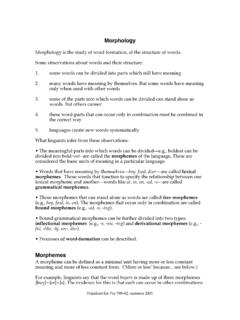Transcription of Kindergarten Common Core State Standards: California
1 Kindergarten Common core State standards : California Kindergarten Common core standards : Reading Kindergarten Common core standards : Reading standards for Literature (RL) Informational Text (RI). KEY IDEAS AND DETAILS. With prompting and support, ask and answer questions With prompting and support, ask and answer questions about about key details in a text. key details in a text. With prompting and support, retell familiar stories, With prompting and support, identify the main topic and retell including key details. key details of a text. With prompting and support, identify characters, settings, With prompting and support, describe the connection and major events in a story. between two individuals, events, ideas, or pieces of information in a text.
2 CRAFT AND STRUCTURE. Ask and answer questions about unknown words in a text. With prompting and support, ask and answer questions about (See grade K Language standards 4-6 on pages 25-26 unknown words in a text. (See grade K Language standards for additional expectations.) CA 4-6 on pages 25- 26 for additional expectations.) CA. Recognize Common types of texts ( , storybooks, poems, identify the front cover, back cover, and title page of a book. fantasy, realistic text). With prompting and support, name the author and Name the author and illustrator of a text and define the role of illustrator of a story and define the role of each in telling each in presenting the ideas or information in a text. the story. INTEGRATION OF KNOWLEDGE AND IDEAS.
3 With prompting and support, describe the relationship With prompting and support, describe the relationship between illustrations and the story in which they appear between illustrations and the text in which they appear ( , ( , what moment in a story an illustration depicts). what person, place, thing, or idea in the text an illustration depicts). (Not applicable to literature) With prompting and support, identify the reasons an author gives to support points in a text. With prompting and support, compare and contrast the With prompting and support, identify basic similarities in adventures and experiences of characters in familiar and differences between two texts on the same topic ( , in stories. illustrations, descriptions, or procedures).
4 RANGE AND LEVEL OF TEXT COMPLEXITY. Actively engage in group reading activities with purpose Actively engage in group reading activities with purpose and and understanding. understanding. a. Activate prior knowledge related to the a. Activate prior knowledge related to the information information and events in texts. and events in texts. b. Use illustrations and context to make predictions b. Use illustrations and context to make predictions about text. about text. Reading Foundational Skills (RF). PRINT CONCEPTS. Demonstrate understanding of the organization and basic features of print. SAN DIEGO COUNTY OFFICE OF EDUCATION (2012) COLLEGE AND CAREER READINESS SERIES. a. Follow words from left to right, top to bottom, and page by page.
5 B. Recognize that spoken words are represented in written language by specific sequences of letters. c. Understand that words are separated by spaces in print. d. Recognize and name all upper- and lowercase letters of the alphabet. PHONOLOGICAL AWARENESS. Demonstrate understanding of spoken words, syllables, and sounds (phonemes). a. Recognize and produce rhyming words. b. Count, pronounce, blend, and segment syllables in spoken words. c. Blend and segment onsets and rimes of single-syllable spoken words. d. Isolate and pronounce the initial, medial vowel, and final sounds (phonemes) in three-phoneme (consonant-vowel-consonant, or CVC) words.* (This does not include CVCs ending with /l/, /r/, or /x/.). e. Add or substitute individual sounds (phonemes) in simple, one-syllable words to make new words.
6 F. Blend two to three phonemes into recognizable words. CA. PHONICS AND WORD RECOGNITION. Know and apply grade-level phonics and word analysis skills in decoding words both in isolation and in text. a. Demonstrate basic knowledge of one-to-one letter-sound correspondences by producing the primary or many of the most frequent sound for each consonant. b. Associate the long and short sounds with Common spellings (graphemes) for the five major vowels. ( identify which letters represent the five major vowels (Aa, Ee, Ii, Oo, and Uu) and know the long and short sound of each vowel. More complex long vowel graphemes and spellings are targeted in the grade 1 phonics standards .) CA. c. Read Common high-frequency words by sight ( , the, of, to, you, she, my, is, are, do, does).
7 D. Distinguish between similarly spelled words by identifying the sounds of the letters that differ. FLUENCY. Read emergent-reader texts with purpose and understanding. Bold, underlined text = California additions to the Common core Kindergarten Common core State standards : California Writing (W). TEXT TYPES AND PURPOSES. Use a combination of drawing, dictating, and writing to compose opinion pieces in which they tell a reader the topic or the name of the book they are writing about and State an opinion or preference about the topic or book ( , My favorite book is ..). Use a combination of drawing, dictating, and writing to compose informative/explanatory texts in which they name what they are writing about and supply some information about the topic.
8 Use a combination of drawing, dictating, and writing to narrate a single event or several loosely linked events, tell about the events in the order in which they occurred, and provide a reaction to what happened. PRODUCTION AND DISTRIBUTION OF WRITING. (Begins in grade 2) CA. With guidance and support from adults, respond to questions and suggestions from peers and add details to strengthen writing as needed. With guidance and support from adults, explore a variety of digital tools to produce and publish writing, including in collaboration with peers. RESEARCH TO BUILD AND PRESENT KNOWLEDGE. Participate in shared research and writing projects ( , explore a number of books by a favorite author and express opinions about them).
9 With guidance and support from adults, recall information from experiences or gather information from provided sources to answer a question. (Begins in grade 4). RANGE OF WRITING. (Begins in grade 2) CA. Speaking & Listening COMPREHENSION & COLLABORATION. Participate in collaborative conversations with diverse partners about Kindergarten topics and texts with peers and adults in small and larger groups. a. Follow agreed-upon rules for discussions ( , listening to others and taking turns speaking about the topics and texts under SAN DIEGO COUNTY OFFICE OF EDUCATION (2012) COLLEGE AND CAREER READINESS SERIES. discussion). b. Continue a conversation through multiple exchanges. Confirm understanding of a text read aloud or information presented orally or through other media by asking and answering questions about key details and requesting clarification if something is not understood.
10 A. Understand and follow one- and two-step oral directions. CA. Ask and answer questions in order to seek help, get information, or clarify something that is not understood. PRESENTATION OF KNOWLEDGE AND IDEAS. Describe familiar people, places, things, and events and, with prompting and support, provide additional detail. Add drawings or other visual displays to descriptions as desired to provide additional detail. Speak audibly and express thoughts, feelings, and ideas clearly. Bold, underlined text = California additions to the Common core Kindergarten Common core State standards : California Language CONVENTIONS OF STANDARD ENGLISH. Demonstrate command of the conventions of standard English grammar and usage when writing or speaking.
